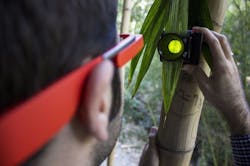In the company of a handheld device, a new Google Glass app enables quick, noninvasive analysis of a plant's health. The app analyzes the concentration of chlorophyll—the plant substance responsible for converting sunlight into energy. (Reduced chlorophyll can indicate degradation of water, soil, or air quality.)
Developed in the lab of Aydogan Ozcan, associate director of the UCLA California NanoSystems Institute and Chancellor's Professor of Electrical Engineering and Bioengineering at UCLA (Los Angeles, CA), the system uses an image captured by the Google Glass camera to measure the chlorophyll's light absorption in the green part of the optical spectrum.1 The main body of the handheld, LED-based illuminator unit can be produced using 3D printing and it runs on three AAA batteries; with a small circuit board added, it can be assembled for less than $30.
Held behind the leaf, facing the Glass wearer, the illuminator emits light that enhances the leaf's transmission image contrast, indoors or out, regardless of environmental lighting conditions. The wearer can control the device using the Google Glass touch control pad or with the voice command, "Okay, Glass, image a leaf." Glass photographs the leaf and sends an enhanced image wirelessly to a remote server, which processes the data from the image and sends back a chlorophyll concentration reading in less than 10 seconds.
Ozcan explains that the team used five leaf species to calibrate the system, and "this same calibration worked to accurately detect chlorophyll concentration in 15 different leaf species." He adds, "This will allow a scientist to get readings walking from plant to plant in a field of crops, or look at many different plants in a drought-plagued area and accumulate plant health data very quickly."
Current methods for measuring chlorophyll concentration are less flexible. One approach requires removing some of the plant's leaves, dissolving them in a chemical solvent and then performing a chemical analysis. The app and illuminator unit could replace relatively costly and bulky laboratory instruments. Ozcan said that the convenience, speed, and cost-effectiveness of the new system could aid scientists studying the effects of droughts and climate change in remote areas.
1. B. Cortazar, H. C. Koydemir, D. Tseng, S. Fenga, and A. Ozcan, Lab Chip, doi:10.1039/C4LC01279H (2015).

